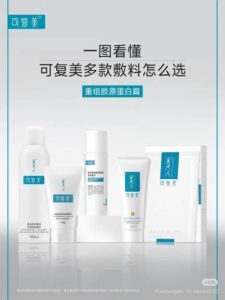Light medical beauty in China, which refers to non-invasive and minimally invasive cosmetic procedures, is booming. Treatments like Botox, Rejuran skin rejuvenation shots, Thermage facelifts, laser toning, and hyaluronic acid (HA) fillers have moved from niche to mainstream, especially among young consumers.
Once a luxury, these “lunchtime procedures” are now seen as part of everyday self-care. The market grew over 15% annually before 2022 and rebounded quickly post-pandemic. In 2021, China’s medical aesthetics market reached RMB 227 billion (US$32 billion), second only to the U.S., and is projected to overtake it by the mid-2020s, drawing comparisons to South Korea, Asia’s long-time cosmetic surgery leader.
Why it’s booming in China
China’s millennials and Gen Z are highly appearance-conscious and willing to invest in looking good. Surveys show almost 50% of young women and 20% of young men are open to medical beauty procedures. For this generation, these treatments are not taboo, but a form of routine self-enhancement. Many begin in their early 20s, viewing it as “essential rather than optional” in their self-care. This trend aligns with the broader “beauty value economy,” where physical attractiveness is seen as an asset in both social and professional life.
Key platforms shaping the ecosystem
SoYoung (新氧) is the first and leading dedicated medical aesthetics platform in China, SoYoung serves as a one-stop hub for cosmetic procedure seekers. Launched in 2013 and publicly listed on NASDAQ since 2019, SoYoung lets users research treatments and clinics, read thousands of “beauty diaries” (detailed user reviews with before/after photos), consult with doctors, and book appointments online. The app even employs AI to recommend procedures based on user selfies.
While not a booking platform, RED (小红书) plays a major role in guiding medical beauty decisions in China. Users share detailed, first-hand accounts of procedures, helping others vet treatments and clinics. Influencers and doctors use the platform to introduce new technologies or warn against scams, while clinics collaborate with popular bloggers to showcase results. The “light medical beauty” hashtag alone has over 270 million views.
Together, content communities (like RED) educate and generate interest; marketplace apps (like SoYoung) facilitate discovery, price comparison, and purchasing; and user review systems create transparency and accountability.
China vs. Korea: the shift in medical aesthetic tourism
South Korea built its dominance through early acceptance of cosmetic surgery, advanced techniques, and the aspirational pull of K-pop and K-drama. At its peak, over 100,000 foreign patients, many from China, visited annually for cosmetic procedures. Clinics tailored packages for Chinese clients, offering translators, airport pickups, and shopping tours.
Today, more Chinese consumers are staying home for treatments. Domestic clinics in Shanghai, Beijing, Shenzhen, Guangzhou, and Chengdu now match Korea’s offerings in skill and technology.
National pride also plays a role. The Guochao (国潮) movement, already transforming fashion and beauty, is now influencing medical aesthetics. Chinese brands like Imeik (爱美客) and Bloomage Biotech (华熙生物) produce high-quality fillers and toxins that compete directly with global brands such as Allergan’s Botox and Restylane.
Skincare brands riding the light medical beauty wave
The light medical beauty boom has not only transformed services, but also catalyzed the growth of related product brands that cater to consumers’ needs before, during, and after these procedures. In China, both domestic and foreign brands are vying to become the go-to choices for the post-treatment skincare and cosmeceuticals that complement light medical aesthetics.

CICABEL (可复美), specializes in recombinant human collagen products designed for post-procedure healing. Its medical-grade masks, gels, and dressings are dermatologist-recommended to reduce redness, repair the skin barrier, and prevent scarring.

Winona (薇诺娜), originally known for sensitive skin formulas, it has repositioned as a “pre-and-post” treatment skincare brand. Backed by Yunnan-Baiyao, it offers dermatologist-developed products suited for Asian skin. It competes with foreign brands like Avène by blending scientific credibility with national pride.
The dark side: Risks, scams, and counterfeits
The industry’s rapid rise has been shadowed by illegal clinics, counterfeit products, and deceptive marketing. Issues include heavily edited before/after images, fake reviews, and unapproved medical injectables. RED has banned dozens of accounts for “虚假种草” (fake endorsements), where influencers promote services they’ve never used.
Faced with these challenges, the Chinese government and industry regulators have stepped up enforcement in recent years. For example, Hangzhou conducted a high-profile 100-day campaign in 2021 targeting unlicensed aesthetic providers. Nationwide, in 2020 the government issued directives to strengthen supervision of the medical beauty industry, focusing on high-risk areas like injectable use and certification of practitioners. Online platforms have been ordered to police content. As noted in news, RED banned 39 medical beauty institutions in one sweep for false marketing and stepped up AI monitoring of content.
What’s next: trends shaping the future
Light medical beauty in China boom shows no signs of abating. In fact, all indicators suggest that the industry will continue to expand and evolve, reshaping consumer attitudes towards beauty and aging in the process. Looking ahead, a few key future trends and implications stand out:
- Subtle transformations: The new aesthetic is a “refined, natural look” over dramatic changes.
- China as the global leader: The medical aesthetics market is projected to exceed RMB 410 billion by 2025, with the light segment reaching RMB 175+ billion in 2024.
- Higher quality standards: Expect stricter clinic accreditation and visible consumer ratings.
- Tech-driven personalization: AI skin analysis, biotech-based injectables, and regenerative treatments will make procedures increasingly customized.
